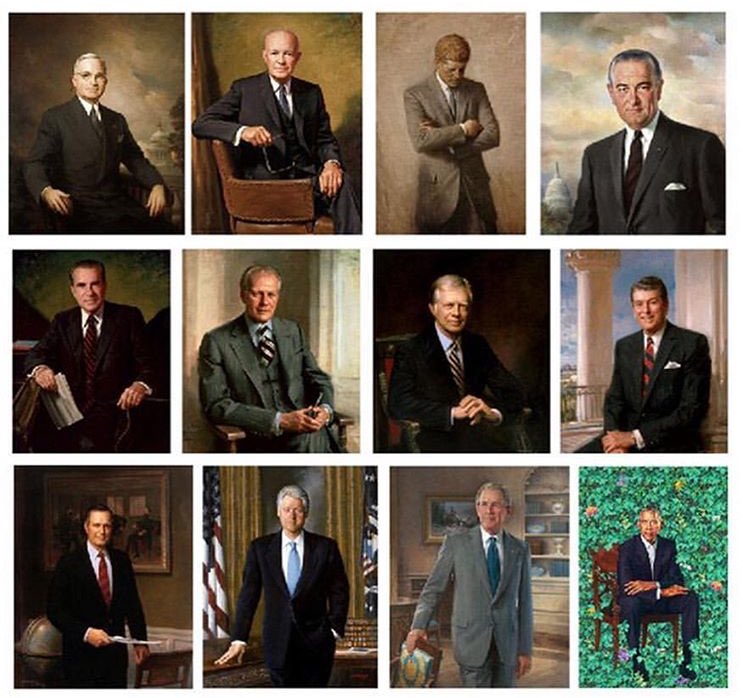

The mid-tones of his full cheeks and rounded chin are made up of tangerine, yellow ochre, olive green, eggplant, violet, and even crimson. On the left side of the canvas, where the light hits the president’s face, the diamond tiles are filled with pale aqua, peach, and sage green. At the center of the composition, Close used unexpectedly bright hues to form the oval of Clinton’s face and hair. They resemble nesting blocks of different colors and shapes.
#Official presidential portraits series#
While each diamond is roughly two and a half by two and a half inches, some of them are joined together to form larger rectangles and L-shapes.Ĭlose then filled these geometric fields with a series of loosely painted, multi-colored concentric circles, teardrops, or rectangles. Since diagonal lines form the grid instead of horizontals and verticals, the painting is made up of diamonds instead of squares. He then used the grid as a guideline to enlarge the photograph, transferring and transforming the visual information from each segment to the canvas. Close made a grid on both the original photograph and the canvas.

When we are near the portrait, Clinton’s likeness takes a back seat to Close’s technique. Let’s explore the mosaic-like composition. As a result, this portrait of the forty-second president remains a puzzle-like abstraction, even though it alludes to a realistic photograph. Similar to pixels on a screen, the painting is composed of hundreds of color-filled diamonds. Second, while the work is based on a photograph, it is far more abstract than a typical headshot. This means that his face alone is several feet high, making it about the same size as some of the full-length, life-size portraits in the “America’s Presidents” exhibition. The first is its size, given that the artist Chuck Close only shows Clinton’s head and shoulders. In this large-scale portrait of Bill Clinton, two things stand out. Turpin and his wife, Suromitra Sanatani, with the newest presidential portrait.Bill Clinton by Chuck Close, 2006, oil on canvas, nine feet tall by seven feet wide. President Turpin has been presented with a framed reproduction. President Turpin’s portrait has been installed in the South Academic Building as part of a newly refreshed exhibition in the hallway outside the President’s Office.īoth the portrait and the sketch on which it is based officially join the University of Alberta Museums Art Collection. U of A presidential portraits by David Goatley He also painted President Turpin when he completed his term as President of the University of Victoria. It is the third presidential portrait he has painted for the U of A, as he painted presidents emeriti Rod Fraser and Indira Samarasekera. The piece was painted by internationally renowned portrait artist David Goatley. Catherine Swindlehurst, Interim VP (University Relations), and Kate Chisholm, Board Chair, unveiling the presidential portrait. The portrait was sponsored entirely by generous donors. President Turpin’s portrait was unveiled before an uncharacteristically small gathering (due to COVID-restrictions) on June 18, 2020. “David, it will be an honour to hang your portrait alongside these distinguished leaders.” Kerr, Robert Newton, Andrew Stewart, Max Wyman, Harry Gunning, Myer Horowitz, Roderick D. The U of A Museums Art Collection currently holds more than 30 such portraits, including the portraits of past university presidents on display in the South Academic Building on North Campus: L to R, from top: Henry Marshall Tory, Robert C. Since its founding, the University of Alberta has commemorated its presidents, chancellors and other significant individuals through commissioned portraits. Turpin, CM, PhD, LLD, FRSC - 13th president and vice-chancellor of the University of Alberta


 0 kommentar(er)
0 kommentar(er)
